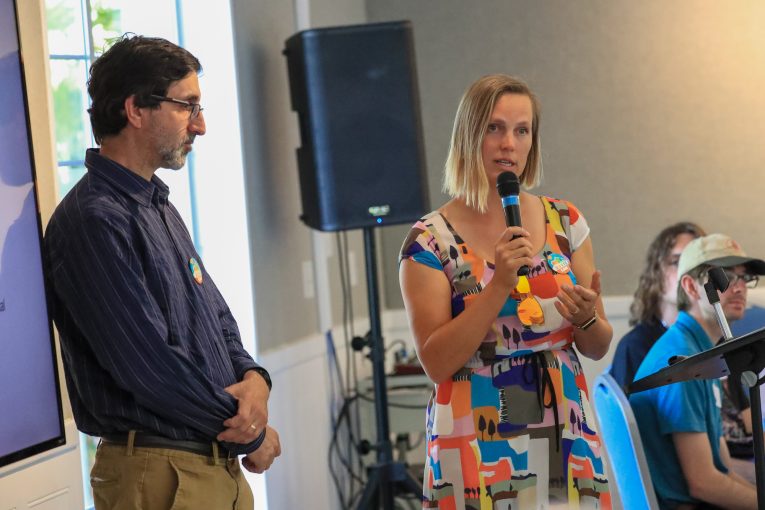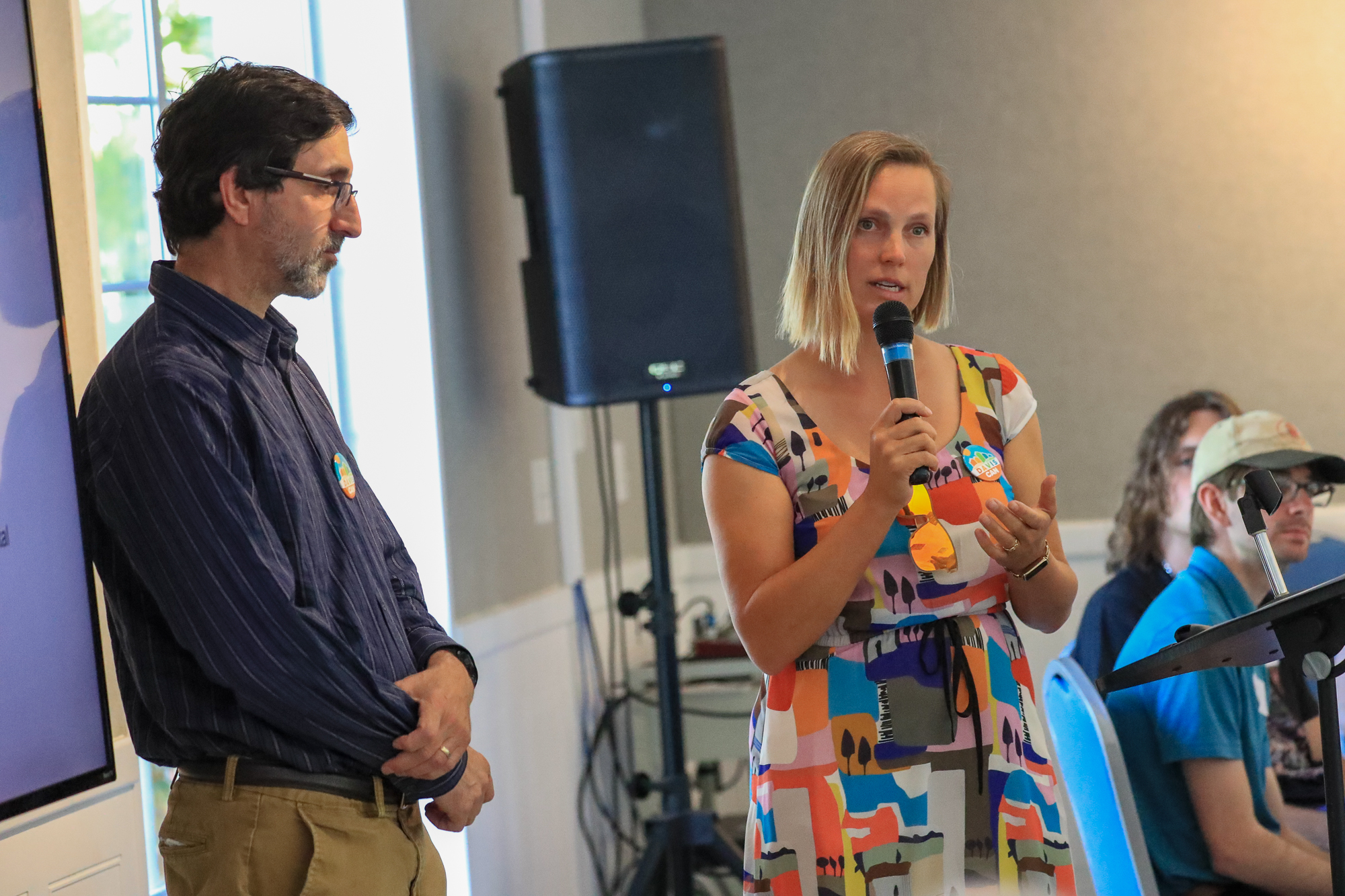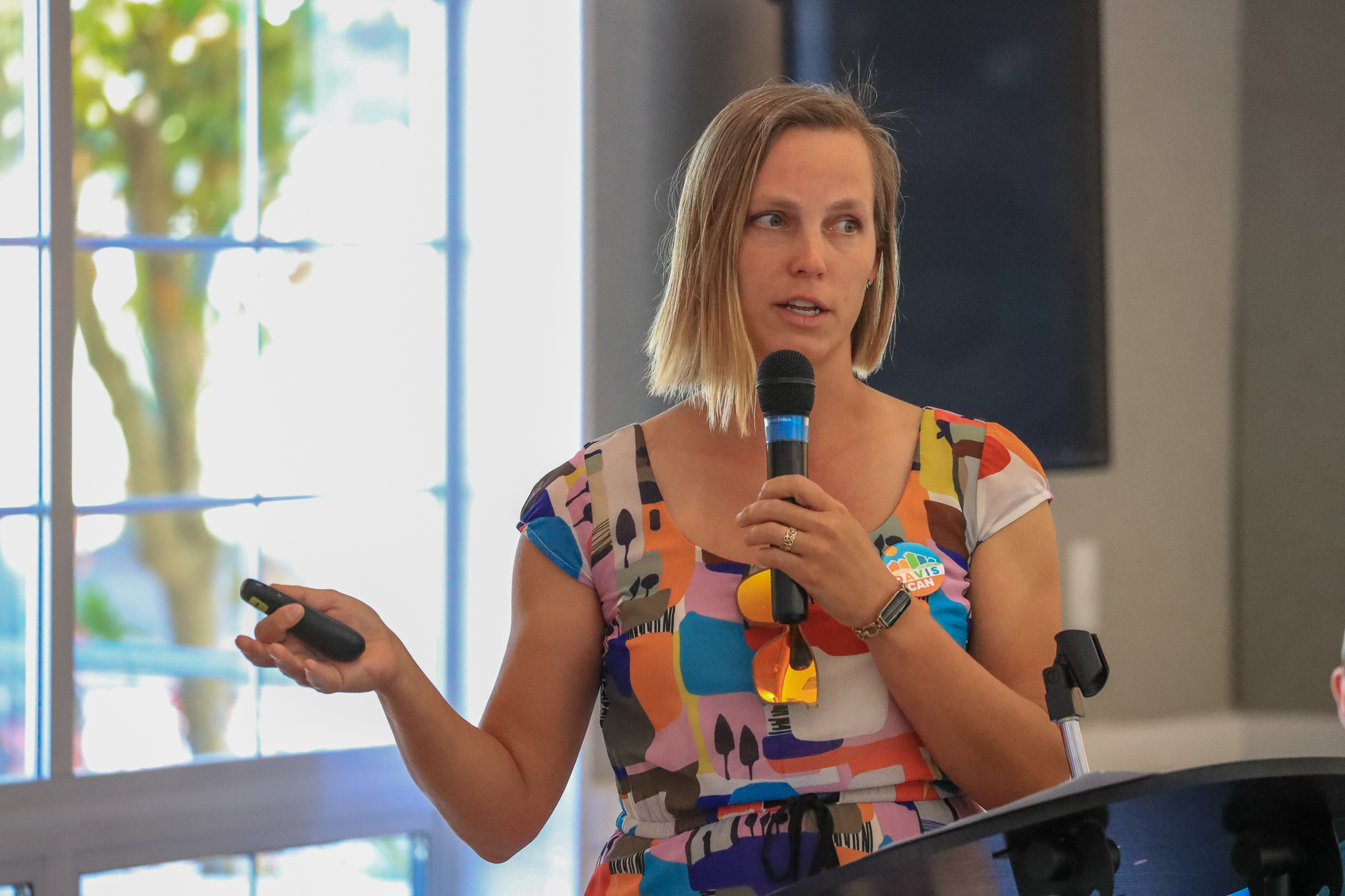

By David M. Greenwald
Executive Editor
Davis, CA – What is the link between affordable housing and climate justice? That’s a critical part of the conversation that often gets omitted from housing and climate change discussions.
This was the subject of a talk last Sunday at the Davis CAN where Jonathan London and Catherine Brinkley from the UC Davis Center For Regional Change discussed the issues of climate justice and affordable housing.
“These two pieces of climate justice and affordable housing and how they really need to be brought together,” London explained during his talk last Sunday. “This idea that they’re really joined at the hip, when we separate them, we run the risk of not achieving either because housing justice really truly is climate justice and we can’t have one without the other.”
He explained, “But climate justice and injustice is really about the structural and historical and global dynamics where those who have been least responsible for the problem are bearing the greatest brunt of the impacts.”


The key point he raised is that, while Europe and the US are the biggest contributors to carbon emissions, the biggest impacts are felt by the underdeveloped countries.
He explained that “if you see the climate impacts, you see a very different picture. You see the United States and Europe taking a very tiny hit of those kinds of impacts and people in the global south having a much greater impact.”
He continued, “You can see the poorest half of the population of the world were responsible for only 6% of the climate emissions, whereas the wealthiest 10 percent were responsible for almost 50%. You really see this great global injustice.”
London described that this isn’t just heat—it’s all sorts of health impacts.
But importantly, “The unhoused are hugely affected (by this) for really obvious reasons. They don’t have the buffers that many of us have in our lives.”
After he pointed out all the ways the poor are disproportionately impacted by climate change including lack of shelter, lack of economic buffers, transportation, air conditioning and the like, he noted that “climate injustice touches all of us, but it touches different ones of us in different ways to different degrees.”
He noted, “The climate justice to housing justice is the … scandalous, horrible, way out of control problem of affordable housing.” He noted that in Davis, “people paying way far beyond their means for housing, over 30 percent (of their take home income) which is the definition of housing burden.”
He added, “97 percent in this placement that we’re in right now are paying over 30 percent of their income on housing.”

Catherine Brinkley is taking over as director of the UC Davis Center for Regional Change.
Brinkley explained the housing portion of this equation, starting with RHNA, saying “first what happens is regional governments get together and determine how much housing needs to be built. This is called the Regional Housing Needs Assessment. It results in a regional housing needs allocation.”
She explained, “Affordable is determined as it should be, no more than 30% of a monthly household income for rent and utilities. If it’s beyond that, then a family is  considered rent burdened.”
considered rent burdened.”

She said, “The median rent in Davis is about $2,500. In order to afford just that rent, not utilities on top of it, you would have to earn at least a hundred thousand dollars a year, which is, you know, an associate professor salary perhaps.”
About 20 percent of the people who live in Yolo County, live below the poverty line, which for a family of four is less than $26,000.
Brinkley explained “that’s nowhere near what’s needed for just housing.”
The current RHNA called for Davis to put together a plan to build over 2000 units of housing, of which 930 were meant for lower income households, and another certain percentage for very low and median income households.
Brinkley talked a bit about the General Plan process and what that entails.
“Davis has a long history of wanting to preserve farmland, not growing out, but also sadly, not growing up,” she said. “It had a one percent growth cap.”
She noted that recently the state added a requirement to address environmental justice.
“Believe it or not, our General Plan does not yet use that term, environmental justice.”
Brinkley referred people to a website to be able to search city and county general plans. She looked at how many addressed things like environmental justice and racism, compared to, say, golf courses.
She noted that while nearly every city addresses golf, only two address racism (redlining, segregation, housing and affordability) while only 93 of 482 cities mentioned even the term environmental justice (and just 19 of 58 counties).”
Brinkley said, “There’s a lot of work to be done and if communities aren’t already talking about it, they’re not planning to change it—which means it’s not going to happen.”

Jonathan London asked, “What would it look like for us to say Davis can link affordable housing and climate justice?”
He said, “So there’s everything from social, racial and environmental justice, which we’ve talked about a bit. Climate education and engagement, indigenous climate action just transitions, community resilience and adaptation.”
London talking about the notion of “just transition.”
He said, “It’s really about not just going from stopping burning fossil fuels and putting up, you know, industrial scale solar. It’s much bigger than that. It’s really transforming the economy, the politics, the society, the culture as a whole, and going from this extractive economy towards a living economy across all of these different dimensions.”
Pulling from an article in Nature, he said, “It’s everything from energy efficiency, and all of these things have an equity lens.”
He asked “who is getting access to these kinds of energy efficiency technologies—renters, low-income people and so on, to deal with these energy burdens as well as these rent burdens that we’ve talked about?”
London noted the “discourse on climate justice” is being “co-opted by folks who don’t want any kind of new housing because, for an environmental basis,” he said, “But if we’re not going to have housing in town, that’s going to mean some density, because people are going to live somewhere.”
He said, “So they’ll be commuting in from other places across the causeway from north to south. And that’s going to be adding to climate change and air pollution.”







So therefor Davis must build more housing?
That comes out to $650/month left for housing so they won’t be burdened. How is Davis going to build and sell or rent homes or apartments for $650/month for a family of four?
Section 8 Vouchers
A lot of landlords won’t take those.
The problem with vouchers and Affordable housing is that it ultimately traps people into purposefully maintaining low income, to qualify.
Ultimately handicapping those in need, and harming society and productivity as a whole. Maintaining segregation indefinitely, as well. You can see an example of this in regard to the federal government’s housing projects.
That’s one reason that rent control is preferable – since there are no income limitations for tenants.
Rent control is fine, but it’s not going to solve the $650/ mo housing need.
The problem is income, in that case.
The very thing that Section 8 and Affordable housing applies limitations to, thereby trapping those same people into an extremely low level of income indefinitely.
Do you have any statistics regarding the number/percentage of people who actually “escape” from that situation?
And if none of this is known (and/or there’s no plan to enable those entrapped), why is this being looked at as a permanent solution? (For a select/small “handful” of people, for that matter.)
Did we learn nothing from federal housing projects?
Davis of course is part of the larger Yolo County market. Building more affordable housing here relieves housing demand in other Yolo communities, thus lowering the rental prices across the county. There isn’t necessarily a simplistic straight line from one action to a result.
So, this article starts out by talking about wealthier countries (such as the U.S., and Europe) creating disproportionate climate impacts for poorer countries – which emit fewer greenhouse gasses in the first place.
Check.
Then, it attempts to tie in Davis as a “victim”, as if it were one of these poorer areas of the world. (No one even able to afford greenhouse-emitting cars, etc.) Apparently, none of these people have stepped foot in an actual poor area of the world, let alone a poor part of THIS country, or even within California.
Doesn’t make a lot of sense.
Oh, wait, maybe they were talking about DISC, regarding the following quote?
And in regard to the following, perhaps they were talking about the “Davis-connected buyer’s program” at WDAAC:
Perhaps some advance notice can be published regarding the next meeting of this group.
That analysis does not represent reality.
The RHNA requirements are mandates from the state, not some bottom-up process originating from regional governments.
And the mandates themselves have no basis in reality. Ask the state auditor about that.
When she says Regional Governments she means SACOG and the other corresponding Regional Government Orgs.
I find it particularly interesting that this UC Davis Center For Regional Change director, is silent on how UCD can and should be producing far more high-density on campus housing for UCD not only for students but for UCD faculty and Staff. UCD has reserved land for faculty and staff housing for years but has not made any progress on that needed on-campus housing.
UCD is the largest UC campus with over 5,300 acres with a 900-acre core campus, yet it continues to only build 4 story with a rare 5-story student housing building it does build any on-campus housing. Meanwhile while a 7-story student housing project was built in the City by a private developer. Why is Orchard Park only 4 stories of sprawling buildings when right across the street is the 7-story privately developed student housing project in the City?
Ms. Brinkley should be talking about how UCD’s Solano Park on-campus student housing being planned for redevelopment, needs to be a minimum of 7-stories, as is being done on other campuses like UC Irvine, and UC San Diego where even taller student housing is being built (16-23 stories).
Also, to help towards correcting the housing situation, she needs to pressure UCD to build at least 50% on-campus student housing like all the other UCs. It is inexcusable that UCD, with plenty of land to accomplish this, and the ability to build far more on-campus housing, continues to resist providing the needed on-campus housing for its large student population. It is also inexcusable that UCD has been pushing 71% of its student population off campus creating enormous impacts on Davis and surrounding communities.
Good catch, and your point demonstrates the underlying hypocrisy of UCD. Hiring someone to badger the community, while doing nothing about the problem that they themselves created (and purposefully ignored for years, if not decades).
Hopefully, someone will confront this director if there’s a subsequent event. Someone from outside of CAN, obviously.
https://gcr.ucdavis.edu/mou-city-county-university
I assume that UCD is fulfilling their obligations under this MOU?
Those impacts include enabling the off campus construction, renovation and renting out of housing to students and employees. If those people moved to on campus housing, many of those landlords could go bankrupt.
Actually, we don’t know since we have not gotten data back yet from UCD, but the campus student population is at least 38,000 now and the maximum student population is not supposed to exceed 39,000 by 2031. Since this is eight years away and UC is pressuring UC’s to admit even more students, clearly, UCD is going to exceed 39,000 well before 2031.
Regarding the MOU, it is completely inadequate because it does not address the many years that UCD neglected to build the needed on- campus student housing as it accelerated it student population growth. This resulted in the huge backlog of on-campus student housing needed now. There is still, a huge deficit of UCD on-campus housing.
So, the bottom line its that UCD has not planned enough on-campus housing and they are clearly going to exceed their inadequately planned “target” of 39,000 in the most recent LRDP. UCD needs to be planning far more and far higher density on-campus housing starting with Solano Park on campus, which is being planned for redevelopment now. Solano Park needs to be at least 7-story student housing as has been built in the City by private developers.